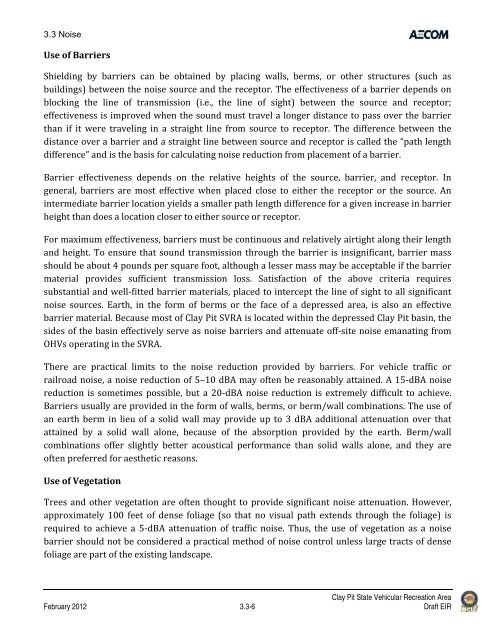Draft Environmental Impact Report - California Off Highway Vehicle ...
Draft Environmental Impact Report - California Off Highway Vehicle ...
Draft Environmental Impact Report - California Off Highway Vehicle ...
Create successful ePaper yourself
Turn your PDF publications into a flip-book with our unique Google optimized e-Paper software.
3.3 Noise<br />
Use of Barriers<br />
Shielding by barriers can be obtained by placing walls, berms, or other structures (such as<br />
buildings) between the noise source and the receptor. The effectiveness of a barrier depends on<br />
blocking the line of transmission (i.e., the line of sight) between the source and receptor;<br />
effectiveness is improved when the sound must travel a longer distance to pass over the barrier<br />
than if it were traveling in a straight line from source to receptor. The difference between the<br />
distance over a barrier and a straight line between source and receptor is called the “path length<br />
difference” and is the basis for calculating noise reduction from placement of a barrier.<br />
Barrier effectiveness depends on the relative heights of the source, barrier, and receptor. In<br />
general, barriers are most effective when placed close to either the receptor or the source. An<br />
intermediate barrier location yields a smaller path length difference for a given increase in barrier<br />
height than does a location closer to either source or receptor.<br />
For maximum effectiveness, barriers must be continuous and relatively airtight along their length<br />
and height. To ensure that sound transmission through the barrier is insignificant, barrier mass<br />
should be about 4 pounds per square foot, although a lesser mass may be acceptable if the barrier<br />
material provides sufficient transmission loss. Satisfaction of the above criteria requires<br />
substantial and well‐fitted barrier materials, placed to intercept the line of sight to all significant<br />
noise sources. Earth, in the form of berms or the face of a depressed area, is also an effective<br />
barrier material. Because most of Clay Pit SVRA is located within the depressed Clay Pit basin, the<br />
sides of the basin effectively serve as noise barriers and attenuate off‐site noise emanating from<br />
OHVs operating in the SVRA.<br />
There are practical limits to the noise reduction provided by barriers. For vehicle traffic or<br />
railroad noise, a noise reduction of 5–10 dBA may often be reasonably attained. A 15‐dBA noise<br />
reduction is sometimes possible, but a 20‐dBA noise reduction is extremely difficult to achieve.<br />
Barriers usually are provided in the form of walls, berms, or berm/wall combinations. The use of<br />
an earth berm in lieu of a solid wall may provide up to 3 dBA additional attenuation over that<br />
attained by a solid wall alone, because of the absorption provided by the earth. Berm/wall<br />
combinations offer slightly better acoustical performance than solid walls alone, and they are<br />
often preferred for aesthetic reasons.<br />
Use of Vegetation<br />
Trees and other vegetation are often thought to provide significant noise attenuation. However,<br />
approximately 100 feet of dense foliage (so that no visual path extends through the foliage) is<br />
required to achieve a 5‐dBA attenuation of traffic noise. Thus, the use of vegetation as a noise<br />
barrier should not be considered a practical method of noise control unless large tracts of dense<br />
foliage are part of the existing landscape.<br />
Clay Pit State Vehicular Recreation Area<br />
February 2012 3.3-6 <strong>Draft</strong> EIR








